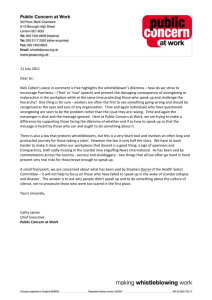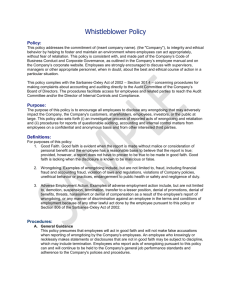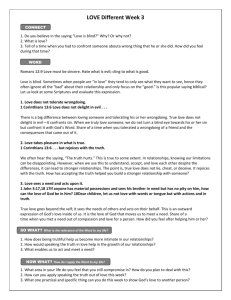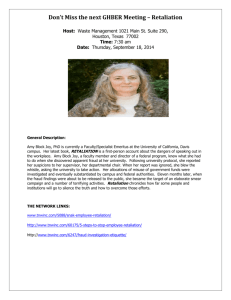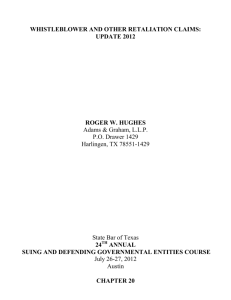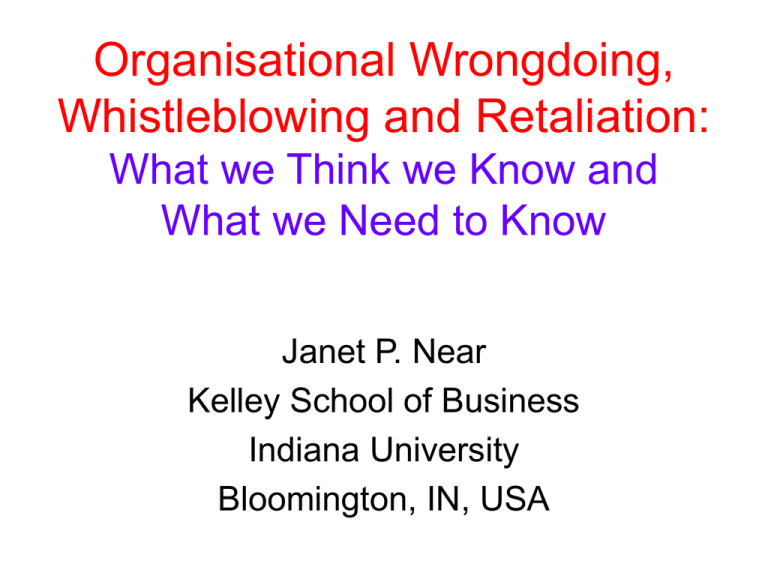
Organisational Wrongdoing,
Whistleblowing and Retaliation:
What we Think we Know and
What we Need to Know
Janet P. Near
Kelley School of Business
Indiana University
Bloomington, IN, USA
Why Does Whistleblowing Matter?
• Costs of organisational wrongdoing in US:
–$5 billion in employee theft
–$350 billion attributable to antitrust
violations
–$300 billion in tax fraud
–$100 billion in health care fraud (Miethe,
1999)
• “Insiders” in better position to observe
wrongdoing and report it than outsiders
Agenda for Today
• What we think we know (US data):
– Overall incidence of wrongdoing,
whistleblowing and retaliation against
whistleblowers
– Predictors of whistleblowing by organisation
members who observed wrongdoing
– Predictors of retaliation against
whistleblowers
– Predictors of effectiveness in the
whistleblowing process
• What we need to know
Theoretical Framework:
Whistleblowing is affected by Power
Relationships among Multiple Social
Actors and the Organisation
Complaint Recipient
Whistleblower
Organisation
Wrongdoer
Legal Issues in US Whistleblowing and Retaliation
• Employment-at-will doctrine
• “Public policy exception”
• Protection from discrimination, sexual harassment, OSHA
violations
• Protection for union employees
• Early state statutes protecting whistleblowers were not used in
cases as often as torte law (Dworkin & Near, 1987, 1997)
• Current state statutes vary (Callahan & Dworkin, 2000; Dworkin
& Callahan, 2004)
• Merit System Protection Act (1978) protects federal employees
from retaliation (USMSPB, 1981, 1993)
• False Claims Act protects others who report fraud against U.S.
government (Callahan & Dworkin, 1992)
• Sarbanes-Oxley (2002) provides federal statutory protection
(only 3 whistleblowers have received a favorable ruling since
2002: Barakat, 2004)
Incidence Information: Federal Employees (1980-1992)
and Directors of Internal Auditing who Observed
Wrongdoing, Blew the Whistle and Suffered Retaliation
(Miceli et al., 1991, 1999)
100%
90%
80%
70%
60%
50%
40%
30%
20%
10%
0%
respondents who
observed wrongdoing
observers of
wrongdoing who blew
the whistle
whistleblowers who
suffered retaliation
1980
1983
1992
internal
auditors
Conceptual Definition of Whistleblowing
“The disclosure by organisation members (former
or current) of illegal, immoral, or illegitimate
practices under the control of their employers, to
persons or organisations that may be able to
effect action” (Near & Miceli, 1985, p. 4).
Implications:
•Internal or external whistleblowing
•Not just recommending changes—has to involve
wrongdoing
•Purpose of whistleblowing is to get wrongdoing
stopped
•Focus on behaviour, not intent
Typical Questionnaire Measure of Wrongdoing: Most
Serious Wrongdoing Observed in the Past 12 Months
• Stealing of federal funds or federal property, accepting
bribes/kickbacks, use of position for personal benefit,unfair
advantage to contractor and employee abuse of office
• Waste of organisational assets, by ineligible people receiving
benefits or by a badly managed program
• Mismanagement including management’s cover-up of poor
performance or false projections of performance
• Safety problems including unsafe or non-compliant products or
working conditions
• Sexual harassment
• Illegal discrimination
• Violation of law
Most Serious Type of Wrongdoing Observed,
US Military Base Sample,
n=1224, 37% of all employees (Near et al., 2004)
45%
40%
35%
30%
25%
20%
15%
10%
5%
0%
Waste
Illegal
discrimination
Mismanagement
Stealing
Sexual
harrassment
Safety problems
Violation of law
Response to Wrongdoing, by Observers of
Wrongdoing, Military Sample, n=1125
(Miceli et al., 2001)
70%
60%
50%
40%
30%
20%
10%
0%
Inactive
observers
Inactive
because others
blew
Internal (only)
whistleblowers
External
whistleblowers
Predicting Whistleblowing:
Individual difference variables
•
•
•
•
•
•
•
Age
Years of service to the organisation
Years of school
Gender (male)
Pay level
Supervisory status
Knowledge of appropriate channels for
reporting wrongdoing
• Feeling of responsibility to report wrongdoing
Predicting Whistleblowing:
Situation variables
• Serious wrongdoing
• Strong evidence
• Supportive supervisors
• Organisation supportive of
whistleblowing
Definition of Retaliation
Conceptual: “undesirable action taken
against a whistleblower—and in direct
response to the whistleblowing—who
reported wrongdoing internally (i.e., within
the organisation) or externally (i.e.,
outside the organisation).” (Miceli & Near,
in press).
Operational: Sum of threatened and actual
retaliations, termed “comprehensiveness
of retaliation” (e.g., Miceli et al., 1999)
Typology of Retaliation
• Work retaliation victimization:
“adverse work-related actions that are
often tangible, formal, and documented
in employment records”
• Social retaliation victimization:
“antisocial behaviours, both verbal and
nonverbal, that often go undocumented”
(Cortina & Magley, 2003: 248)
Types of Retaliation (US Military Sample):
Threatened Experienced
Co-workers not socializing with me
Pressure from co-workers to stop complaint
Tighter scrutiny of daily activities by management
Withholding of information needed to perform job
Personnel/staff withdrawn
Verbal harassment or intimidation
Poor performance appraisal
Professional reputation was harmed
Charged with committing an unrelated offense
Denial of award
Denial of promotion
Denial of opportunity for training
Relocation of desk or work area in office
Imposed access restrictions to areas needed for job
Assignment to less desirable or less important duties
Reassignment to job with less desirable duties
Reassignment to a different geographical location
Security clearance withdrawn
Required to take a fitness-for-duty exam
Suspension from job
Grade level demotion
Fired from job
Other
.4%
2%
2%
1%
0
5%
2%
1%
1%
1%
2%
1%
.4%
1%
2%
1%
0
.4%
1%
0
0
.4%
3%
11%
5%
14%
10%
9%
12%
15%
7%
7%
7%
7%
9%
5%
7%
8%
7%
3%
1%
2%
.4%
.4%
.4%
3%
Predicting Retaliation:
Summary of Results
Most whistleblowers didn’t suffer retaliation,
and those who suffered retaliation did not differ
reliably from other whistleblowers in terms of personal
characteristics, such as age, gender, race, status in
the organisation, pay, etc. (but among federal
employees retaliation was positively related to
education and inversely related to pay, performance
and majority ethnic group: Miceli et al., 1999).
Whistleblowers who did suffer retaliation often
felt that they had less support than others from
managers and supervisors, and they were more likely
to have used external channels to report the
wrongdoing, rather than internal channels exclusively.
Regression of Retaliation (β), Federal Employees (Miceli et al., 1999)
Significant coefficients listed 1980
1983
1992
in red, nonsignificant in blue (n=640) (n=202) (n=353)
Size of agency
-.08*
NA
NA
External channels for WB
.12**
NA
.15**
Education
.10*
.14*
.04
Pay
-.16**
-.04
-.06
Professional job status
NA
-.04
.05
Job tenure
NA
-.10
-.03
Job performance
NA
NA
-.19***
Female
NA
.08
-.05
Majority ethnic group
NA
-.12*
-.13*
Seriousness of wrongdoing
.06
.13*
.09
Management lack of support .18***
.33***
.29***
Supervisor lack of support
.26***
.40***
.16**
Coworker lack of support
-.02
.08
.04
Adjusted R2
.19
.41
.27
*p<.05; **p<.01; ***p<.001
Conceptual Definition of Effectiveness
“the extent to which the questionable or wrongful
practice (or omission) is terminated at least partly
because of whistleblowing and within a reasonable
time frame” (Near & Miceli, 1985: 681)
Basis for definition
• Early finding: whistleblowers themselves perceived
the process to have been effective if they were
successful in changing management’s views about the
wrongdoing (Near & Jensen, 1983)
• Effectiveness is separate from retaliation
Regression (β) of Effectiveness
Controls in black, ns
coefficients in blue, significant
coefficients in red
External channel
Education
Pay
Public sector
Role prescription
Retaliation
Low materiality
Short-term WD
Recipient: top mgmt
Recipient: OIG/AC
Ext x low materiality
External x top mgmt
External x OIG/AC
Adjusted R2
*p<.05; **p<.01;***p<.001
(Miceli & Near, 2002)
1980 MSPB Internal auditors Sexual harassment
(n = 623)
(n = 836)
study (n = 242)
.03
-.01
-.08
-.02
.01
.04
.05
.15**
-.06
NA
-.02
NA
.25**
.14**
NA
-.09**
-.10**
-.32**
.23**
.19**
-.01
NA
.16**
.19**
-.05
.12**
NA
.11**
.10*
NA
.04
.02
-.04
.03
-.07*
NA
-.11***
.04
NA
.15
.17
.18
Implications and Questions for Practice and Theory
Theory:
• Bureaucracy is still the basis for most organisation structures
• Bureaucracy is built on Max Weber’s notion of authority: the
boss rules
• What happens to organisation structure if dissent is permitted?
• What happens to organisation effectiveness if dissent isn’t
permitted?
Practice:
• If lawmakers want to reduce corporate wrongdoing, how can
they persuade insiders to blow the whistle?
• If managers want to improve organisation effectiveness and
prevent lawsuits for wrongdoing, how can they encourage valid
and useful dissent?
• If organisation members want to blow the whistle effectively and
without suffering reprisal, what strategies should they use?

